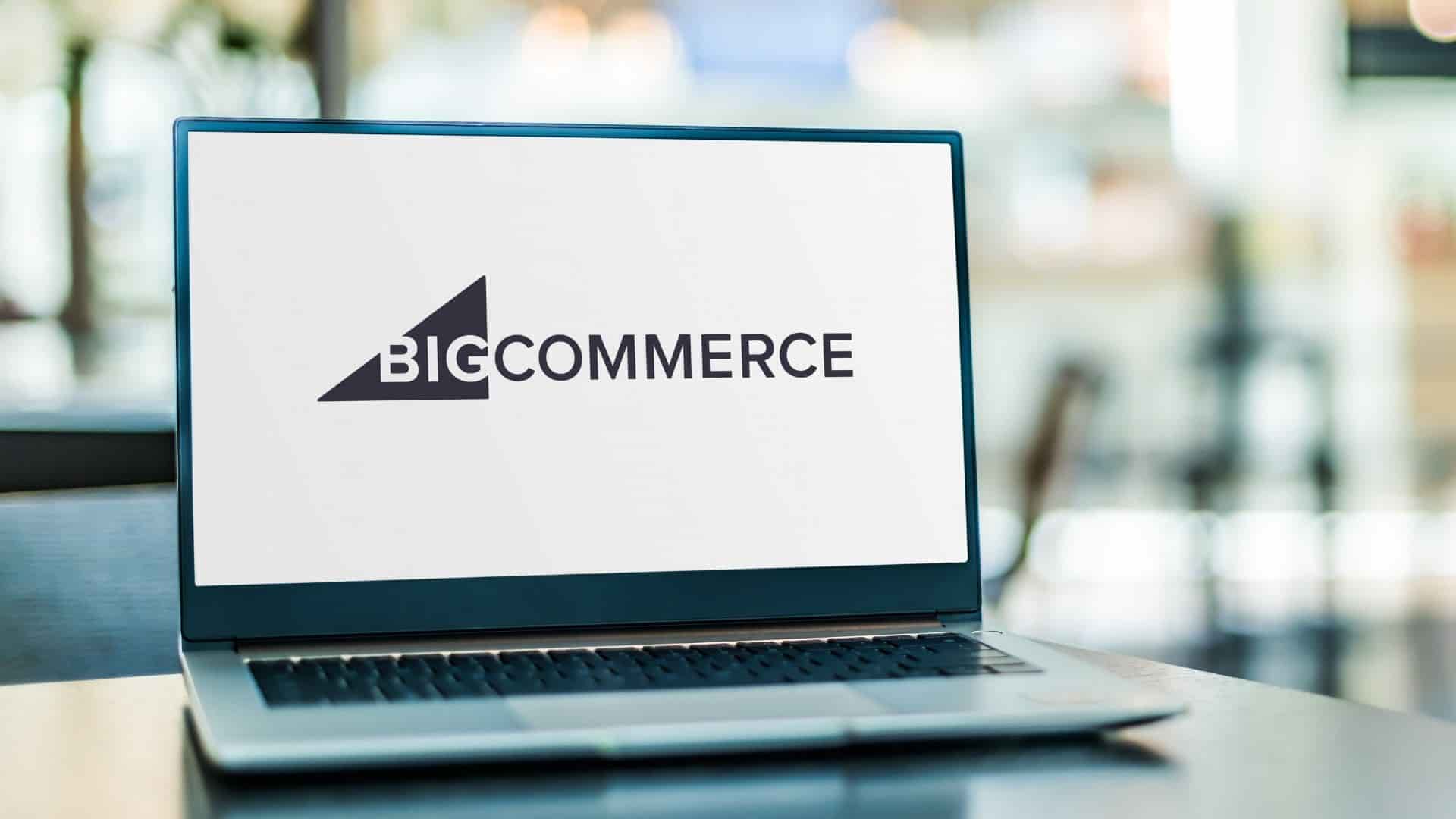Bigcommerce vs Shopify: head to head
Shopify vs BigCommerce: the ultimate showdown. How do the best e-commerce platforms BigCommerce and Shopify stack up against each other and which one should you choose to run your e-commerce business?

Henry Kivimaa

E-commerce has seen massive growth since the internet boom and the emergence of online shopping. As consumers become more comfortable with e-commerce stores, they increasingly make their purchases online instead of visiting traditional brick-and-mortar stores.
This growth has also helped fuel the development of powerful e-commerce platforms that make it easier for online merchants to sell their products, manage their inventory, and provide an enjoyable customer experience.
E-commerce platforms are available in a variety of sizes and complexity levels, ranging from simple shopping cart software to sophisticated enterprise-level solutions. Regardless of what kind of platform you’re looking for, you can’t get past Shopify and BigCommerce.
So, let’s dig in and see what really sets them apart. If you’re in a hurry and just need answers, you’ll see a quick guide below:
| Feature | BigCommerce | Shopify |
|---|---|---|
| Ease of set-up | Good | Very good |
| Fees and pricing | Good | Average |
| Usability | Good | Very good |
| Content marketing | Good | Average |
| Built-in features | Very good | Good |
| Apps/plugins/integrations | Good | Very good |
| Customizability | Average | Good |
| Performance and security | Very good | Very good |
On a high level
Before we get into the nitty-gritty of Shopify vs BigCommerce, let’s quickly go over the basics.
Shopify
Shopify was founded in 2006, and it’s the most popular e-commerce platform, with over 4.1 million live stores. It offers an array of features designed to make running your online business easier. Features include:
- Website and theme customization
- Marketing tools
- Content management
- Social media integrations
- Payment processing
- Shipping options
- And more
Additionally, Shopify offers its own app store with thousands of different apps to help you expand your store’s capabilities.
BigCommerce
BigCommerce was developed in 2009 and has approximately 50 thousand stores online. It’s a comprehensive e-commerce platform offering a range of features and options for merchants, including:
- Easy website setup and customization
- Robust content management
- Integrated payment processing
- Marketing tools
- And much more
Like Shopify, BigCommerce also has a wide selection of third-party integrations and extensions available on its app marketplace to help you customize your store.
But let’s dive a bit deeper into the comparison.
Ease of setup
Getting your online store up and running quickly and easily is paramount for small and medium-sized businesses, so let’s start with that.
BigCommerce

BigCommerce is a fully hosted e-commerce platform, meaning you don’t need to host your own website and can purchase a domain directly from BigCommerce. Domains cost around $15 per year, but the exact price depends on many factors, including the domain’s age and popularity. You can get started with BigCommerce in 5 simple steps.
1. Sign up
Create an account by registering on the website. You’ll need to sign up for the 15-day trial and can then start using your account straight away.
2. Select a theme
You can choose from 12 free themes and 307 paid themes. The paid themes are priced in the range of $150 to $400.
3. Input basic information
You’ll need to enter some basic information like your business name, location, and contact details.
4. Add your products
Products can be added one by one using the menu on the website or by uploading them in bulk using a CSV file. Adding images, product descriptions, and identifiers like SKUs or UPCs is also recommended.
Pro tip: Use Katana’s free SKU generator to quickly generate identifiers for every product variation
5. Add payment and shipping information
Once you’ve added your products, you can configure the payment and shipping options that suit your business. This will require providing further details like taxes, currencies, shipping fees, and payment methods.
You can go back later to add or change the information in the settings, so it’s fine if you miss a step or don’t fill out every field immediately.
Shopify

Shopify is also a fully hosted service that lets you purchase a domain when you sign up. Prices are similar to the ones for BigCommerce but also depend on a myriad of factors. Setting up your store with Shopify is also quite straightforward, and you can have your store ready to go in just a few steps.
1. Sign up
Create an account by registering on the website. Shopify offers a 14-day trial that you can use to get familiar with it before committing to a paid plan.
2. Select a theme
Shopify lets you choose from 11 free themes and has 97 paid themes ranging in price from $100 to $350.
3. Input basic information
In the same way as BigCommerce, you’ll need to enter some basic information like your business name, location, and contact details.
4. Add products
As with BigCommerce, Shopify lets you add items individually or in bulk when uploading a CSV file to the website.
5. Add payment and shipping information
Finally, you configure payment and shipping options that best suit your business needs. This will require entering further details like taxes, currencies, shipping fees, and payment methods.
Overall, both Shopify and BigCommerce are easy to set up and should not present any major issues for merchants. Still, Shopify does have a slight advantage with its more intuitive site structure.
When comparing the free themes, Shopify users get a better variety as BigCommerce themes can look quite similar. Both offer trial periods, which give you ample time to explore the two platforms before committing to a subscription.
Want to see Katana in action?
Katana provides e-commerce sellers with everything they need to manage their inventory, production, and sales.
Fees and pricing
Once the trial period is over, fees and pricing will become important factors for you to consider when choosing between the platforms.
BigCommerce
BigCommerce offers four plans:
- Standard — $29.95/month
- Plus — $79.95/month
- Pro — $299.95/month
- Enterprise — Custom pricing
For Plus and Pro plan subscribers, BigCommerce offers a 10% discount with a yearly subscription.
BigCommerce has volume-based pricing, meaning that if your sales revenue for the past 12 months exceeds a certain threshold, you’ll be moved to a higher-paying plan. The thresholds are the following:
- Standard — Up to $50,000
- Plus — Up to $180,000
- Pro — Up to $400,000
- Enterprise — Custom pricing
So when considering the pricing, you need to take into account your estimated yearly revenues.
In addition to the monthly subscription fee, with most platforms, you would also incur a transaction fee for every sale. BigCommerce does not charge such a fee. It allows you to use 65 pre-integrated online payment solutions that cover 230 countries and 140 currencies with no additional transaction costs.
For credit and debit card transactions, you will have to pay a $0.49 fixed fee and a transaction fee depending on the plan you subscribe to:
- Standard — 2.59%
- Plus — 2.35%
- Pro — 2.05%
Shopify
Shopify offers three main subscription plans with very similar prices to BigCommerce:
- Basic — $29/month
- Shopify — $79/month
- Advanced — $299/month
In addition to the main plans, Shopify also offers a:
- Starter plan — A shopping cart plug-in that can be integrated with social media platforms for $5/month
- Shopify Plus — For large enterprises, the monthly fee starts from $2,000
Unlike BigCommerce, every sale on Shopify incurs an additional fee if you wish to use a different payment gateway to Shopify Payments. The fees charged depend on the plan:
- Basic — 2%
- Shopify — 1%
- Advanced — 0.5%
When opting for Shopify Payments, there is no additional fee. However, it’s only supported in a limited list of countries. You also won’t be able to use Shopify Payments if you’re selling CBD products, BigCommerce does not have such restrictions.
Which countries are supported by Shopify Payments?
Shopify Payments is available in Australia, Austria, Belgium, Canada, Denmark, Czechia, Finland, France, Germany, Hong Kong, Ireland, Italy, Japan, Netherlands, New Zealand, Portugal, Singapore, Spain, Sweden, Switzerland, the United Kingdom, and the United States.
For credit and debit card payments, the fixed fee is $0.30 per transaction, and the variable fees depend on your subscription plan:
- Basic — 2.95%
- Shopify — 2.5%
- Advanced — 2.4%
Overall, Shopify has lower fixed fees but higher variable fees, so if making a lot of lower-value sales, Shopify would come out ahead. But if most transactions are of higher value, it can be cheaper to use BigCommerce.
The fact that BigCommerce doesn’t charge a per-transaction fee no matter which payment gateway you choose can make a huge difference if you have a preferred service provider that you would like to use.
Usability
Next, let’s look at BigCommerce vs Shopify in terms of usability to see which one has a steeper learning curve.
BigCommerce
BigCommerce has a user-friendly interface with a drag-and-drop feature for customizing the store layout. This feature allows you to add new pages, products, or sections quickly and easily. It also offers APIs for integrations, as well as a built-in content management system.
Adding products, checking your sales, and other daily tasks are straightforward., But the menus are a bit more scattered than in Shopify. However, once you familiarize yourself with the structure, there isn’t anything too complex or time-consuming.
Shopify
Shopify is even more user-friendly than BigCommerce, with an intuitive interface that makes it easy to navigate and manage your store. The drag-and-drop feature is also available, allowing you to customize your shop’s look in no time.
Shopify offers a more extensive selection of modules to add to your store, giving you more flexibility. It also provides plenty of APIs, allowing you to integrate with many different e-commerce services and payment gateways, making it easier to manage your store.
In terms of usability, it’s hard to beat Shopify — but BigCommerce comes very close. Both are great options if you’re looking for a user-friendly e-commerce platform.
Content marketing

Regardless of how great your products are, without a solid marketing plan, potential customers won’t be able to find you, and you won’t make any sales. That’s why looking for a platform that offers robust content marketing tools to help you promote your store is important.
BigCommerce
Right out of the box, BigCommerce comes with the following features for content marketing:
- Discount codes — Create coupons for shoppers to use
- Gift certificates — Generate gift certificates for any amount specified
- SEO settings — Customize title tags, meta descriptions, and change alt text on images
- Pre-built integrations — Connect easily to Google Shopping, Amazon, Walmart, eBay, etc.
- Reporting tools — Track the performance of your products and see how you acquired customers
This gives you a good set of tools to get started, but you should still consider adding an additional email marketing app.
Shopify
Shopify offers most of the same features with a few key differences. If BigCommerce has prebuilt integrations to the most popular shopping platforms, Shopify users need to install an external app for that. These apps often come at an additional cost.
Also, the reporting tools are more limited on Shopify when using the Basic plan, so you would need to subscribe to a higher plan to unlock the full analytics.
On the plus side, Shopify does come with a built-in email marketing tool, cleverly named — Shopify Email. This allows you to quickly create campaigns and set up automated emails to engage your customers.
Overall, both BigCommerce and Shopify offer some standard features for content marketing, but BigCommerce is slightly ahead in this department if you don’t want to install any additional apps.
Katana — your single source of truth
Besides offering you all the tools you need to control your inventory, Katana also integrates with your favorite apps from accounting to e-commerce, allowing you to manage your entire business from a central place.
Built-in features
Both platforms come packed with the essentials for running an online store: shopping carts, payment gateways, a selection of themes, and the like. However, there are a lot of features that can make a huge difference in managing your store but are not included in the standard packages. Let’s take a look at which platform offers more useful features for the price.
BigCommerce
When comparing built-in features included in the cheapest plan, BigCommerce has a lot more to offer. The Standard plan comes with the following:
- Rating and reviews tool
- 65 pre-integrated payment gateways with zero fees
- Unlimited staff accounts
- Advanced reporting
- Real-time shipping rates
In addition, BigCommerce supports up to 600 SKUs, giving you a lot of options to work with. It also has a built-in geolocation feature that shows prices to the customers in their local currency.
Shopify
Shopify’s Basic plan offers fewer features than BigCommerce but has some very valuable ones. But first, let’s see the features that Shopify is missing.
If BigCommerce lets you have up to 600 product variations, Shopify only supports a maximum of 100. This means you will need to install an additional app to offer the same degree of customization.
Shopify also limits the total options to three per product. So, if you sell a shirt and wish to offer the customer the option to choose a size, color, material, and style, you’ll be out of luck unless you install an additional app.
How to get around the 100 product variations limit on Shopify?
Split your product variations into separate items. So, instead of offering one pair of sunglasses and letting buyers choose between seven color options, you can offer seven different color sunglasses with up to three additional customization options each.
Alternatively, you can get an external app that removes the limit. To see which app to choose, check out the article about the Shopify variant limit.
It also doesn’t convert prices to the local currency automatically. Instead, users must select their desired currency from a drop-down menu.
Now, let’s look at the valuable features in more detail included with Shopify’s Basic plan that you don’t get with BigCommerce.
Abandoned cart
This feature allows merchants to recover lost sales by sending automated emails to customers who left their orders incomplete. Research shows that the average cart abandonment rate across all industries is 69.57%.
People who visit your store, add items to the cart, but don’t complete the purchase represent a huge opportunity to get more customers. Clearly, they are interested in what you’re offering, so a quick follow-up email may be all you need to convert them into buyers.
Shopify comes with an abandoned cart recovery tool included in the Basic plan, while BigCommerce users need to upgrade to the Plus plan to access that feature.
When comparing the feature itself, Shopify allows one follow-up email, while BigCommerce lets you schedule and send three.
Regional settings
Another great thing about Shopify is the option to customize the language settings of the store based on the customers’ location. Shopify lets you add 20 different languages for specific regions to the same store. To add additional languages to BigCommerce, you need to install an external app.
With the Advanced plan, you can also set different prices for different regions, making it easy to keep your profit margins consistent.
Taxes

Calculating your taxes can be complex and time-consuming, so it’s great that Shopify can automate that process for you. Shopify can calculate the taxes automatically, saving you a lot of headaches. This is also true when selling in EU countries that follow the VAT MOSS (value-added tax Mini One Stop Shop) scheme.
While BigCommerce offers more features right out of the box, it does require the user to install additional apps or upgrade to the Plus plan to access features such as abandoned cart recovery, regional settings, and automatic tax calculations.
On the other hand, Shopify offers fewer features but comes with a few valuable ones that may save you time and money in the long run. So, you need to make sure you evaluate which features you need the most and choose the plan that fits the best.
Apps, plugins, and integrations

Both BigCommerce and Shopify offer a lot of apps, plugins, and integrations to extend the functionality of your store.
BigCommerce
BigCommerce has more than 1,200 different apps available on the marketplace that allow you to create loyalty programs, track customers, generate shipping labels, and much more. While this amount of apps may seem more than enough, it dwarfs compared to Shopify’s.
Shopify
Shopify’s app store has over 8,000 apps available for you to choose from. This makes it the clear winner in this category. As BigCommerce does include more features out of the box, it may not need as many apps as Shopify.
But the main difference is likely due to the significant contrast in the number of active users. With over 4 million live stores, Shopify has a much larger development community to create apps for its platform, resulting in abundant choices for its users.
Customizability
BigCommerce and Shopify both have a good selection of professional themes, but if you really want to make the store align with your brand, you need some advanced customization options.
BigCommerce
The drag-and-drop feature is intuitive for simple modifications. For more specific changes, though, the templates lack flexibility, and you need to turn to the code editor. If you feel at home with HTML and CSS, it’s not going to be an issue, but if you’re not familiar with web development, you may need to hire someone to do it for you.
Also, BigCommerce widgets only have a limited selection of fonts that you can use. You won’t be able to add any custom fonts either, so if you have a specific font for your brand, you’re out of luck.
One thing BigCommerce nails in the customization department is capturing additional info from your customers.
Suppose you sell mugs with custom writing, jewelry with engravings, or even shirts with custom pictures. With BigCommerce, you can easily add additional fields and file upload modules to your product pages, so buyers can provide you with the text, names, or images they wish to see on their items.
Shopify
Shopify provides more options for customization compared to BigCommerce. The theme editor gives you more flexibility with a wider selection of modules to select, add, and remove as you please. It also allows you to make more subtle design changes such as font color, size, and family.
If you’re in the market of bespoke goods that need additional input from customers, you may have to invest in a paid app unless you’re daring enough to fiddle with the code yourself. That’s because Shopify does not let you add custom fields easily.
So, if you have a nice brand book to follow but aren’t familiar with coding, Shopify will give you more options to tweak the look and feel of your store. On the other hand, if you need more customization options, BigCommerce may be a better bet.
Performance and security

And last, let’s see which platform comes out ahead in BigCommerce vs Shopify in terms of speed and security.
BigCommerce
BigCommerce is known to be marginally faster than Shopify overall. It has a very robust infrastructure that can handle traffic spikes with ease. It also offers multiple layers of security to protect your site from malicious activities and keep buyers’ private data safe.
All hosted BigCommerce stores are protected automatically by the BigComemrce shared SSL certificate. And sites with a custom domain come with a free SSL certificate. You also have the option to purchase paid SSL certificates from BigCommerce, and subscribers to Pro and Enterprise plans can even install third-party SSL certificates.
Shopify
Shopify is no slouch either when it comes to performance, providing one of the most reliable e-commerce platforms around. Even during high-traffic times, your site should stay up and running without any hiccups.
Shopify also offers you free SSL certificates with all plans. However, you are not able to install your own certificates.
To conclude, both platforms boast an industry-leading 99.99% uptime and a secure environment to conduct business. Both offer basic SSL certificates and have a good set of security features in place, so you can rest assured that your customer data is safe.
BigCommerce may come slightly ahead in certain tests, but the lead is small enough that it’s unlikely to be noticed in a real-life setting.
The verdict
We’ve now gone through all the criteria, so it’s time to come to a verdict.
BigCommerce and Shopify are both excellent e-commerce solutions with lots of features and capabilities. They both offer a visually appealing design, great customization options, reliable performance, and robust security. When it comes down to it, which one you choose will depend on your specific needs and budget, but let’s go over the main differences.
Shopify is slightly easier to set up and also has a more intuitive design, making it a winner in setup and useability. It also has a larger app store and comes with email marketing and an abandoned cart tool.
On the other hand, BigCommerce includes a lot more useful features out of the box, including:
- Unlimited staff accounts
- Reviews and ratings tool
- Prebuilt integrations to Amazon, eBay, and others
It also allows you to easily add custom fields, offers six times more product variation, and has prebuilt payment gateways with zero fees.
In the end, it really boils down to which features or characteristic is more important to you. For beginners, Shopify will be a better choice. But for more experienced store owners, BigCommerce might be the right option with its advanced features and functionality.
Getting the most out of your e-commerce store
Clearly, both, BigCommerce and Shopify offer a lot, and it becomes pretty hard to decide which one is better for your store. But regardless of which platform you end up choosing, you can’t go wrong with Katana.
Katana’s live inventory management software offers native integrations with Shopify and BigCommerce so that you can keep your inventory levels and sales orders in sync automatically.
BigCommerce and Shopify come with basic inventory management features, but once your business grows out of the baby shoes, you’ll need more advanced tools to keep everything streamlined. Katana fills the gap and offers everything you need in a single package, including:
- Live inventory management — Manage all four types of inventory (raw materials, work-in-process, finished goods, MRO) in real time
- Real-time master planner — Reprioritize urgent orders with a simple drag-and-drop
- Reorder points — Avoid stockouts and missed sales by always knowing when you need to top up your raw materials or finished goods
- Floor level control — Assign and track tasks remotely and align your shop floor and office team with Katana’s Shop Floor App
- Unified experience — Integrate with your favorite business platforms and keep everything synchronized across all of them
- Sales insights — Get a granular look at your sales performance with Katana Insights
Katana is available on the BigCommerce and Shopify app stores, and you get a free 7-day trial to test it out before you buy when signing up from the app stores.

Henry Kivimaa
Table of contents
Get inventory trends, news, and tips every month
Get visibility over your sales and stock
Wave goodbye to uncertainty with Katana Cloud Inventory — AI-powered for total inventory control